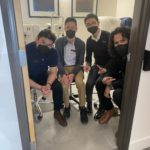
Dr. Helmus’s clinical technician team, a group of employees that evolved from an attempt to add scribes to the practice. It turned out that it was a clinical tech team the practice needed rather than scribes.
By Julie Helmus, OD
April 6, 2022
Like many optometrists, I enjoy the social and problem-solving aspects of patient care. But my least favorite part? Charting! After seven years in practice with the same EHR, my cursor movements are as efficient and rhythmic as a pro fly fisherman with a rod. Nonetheless, on my full days – when I see 22 patients with a patient scheduled every 20 minutes — I often end up with a third to a half of my charts unfinished at close.
Charting feels a lot like homework. Open records hang on me throughout the dinner-bath-bed routine with my young children. After their bedtime, while other adults are kicking back with Netflix (or so I imagine), I log on to my remote server.
“Get a scribe,” I heard from several veteran practice owners and industry consultants. I usually require repeated messaging before it sinks into my stubborn do-it-yourself psyche. I had so many reservations. Our practice had never operated that way; would patients rebel? Is it appropriate to cram another human being into our 13” x 9.5” exam rooms during a pandemic? Would we share one computer or would I have to add another to the lanes? The training alone was daunting.
Qualities to Look for in a Potential Scribe
I never actually posted a job for a scribe. “Jane” applied to a job post for an optician position. Though she had no optical or medical experience, she was calm, polite and even elegant. “Patients would definitely accept her in the exam room,” was my first thought. I pitched the idea of making her a scribe and she accepted a full-time position at $16/hour. The scribe role was more in line with her future nursing aspirations.
What makes an ideal scribe? Someone accurate, attentive, discrete and able to type over 50 words per minute. Perhaps an individual with a quiet demeanor, so the focus remains on the doctor-patient interaction. Basically, a hustling introvert who’s a quick study. They would need a solid understanding of the EHR, and fluency in ocular anatomy and health history. It’s a tall order. Hence why so many of us optometrists delay. But there are other roles within an optometric practice that require a similar skillset…
Training a New Scribe
Jane went through several weeks of orientation during which she learned about all aspects of the practice, from front desk to pretesting to the optical. Meanwhile, we installed standing desks in the exam rooms. She hovered over my shoulder for a few days watching and listening. She was eager to jump in, and taking over case history proved relatively easy for her.
During the refraction, which usually takes me 4-7 minutes, I worried she was bored. The most challenging part was teaching her how to input objective findings and assessment. She got the hang of the most common findings and diagnoses, such as MGD, Blepharitis, NS and PVDs. But anything new required hand holding.
To help her learn ocular anatomy, I purchased the AOA Paraoptometric flashcards and videos. Inputting the plan was relatively straight forward, since she usually just typed my patient education word for word.
Another Person in the Room
With my scribe manning the computer, I enjoyed more eye contact with my patients. I felt more present and connected to the individual in the exam chair, but I also felt like we had an audience. While that “being watched” feeling faded, the doctor-patient exchange is altered by the presence of a scribe in the room. We were all more direct and focused on the exam, more censored, less loose and casual.
Although my wrist and dry eyes enjoyed a recess from computer use, my personal preference is to be alone with the patient in the exam room. We’ve since doubled our capacity from three to six exam rooms, and our three new lanes are even smaller: 9 x 10” with space-saving Epic refracting systems (keep in mind I’m in California where real estate is limited and expensive).
Other Articles to Explore
I ended up ditching the scribe position, and with Jane’s help, expanded the capabilities of our Clinical Tech Team. Jane became Lead Clinical Technician, overseeing three other techs. In our practice, techs are responsible for pre-testing (Optos, AR/AK/IOP and ZEISS visual field screening), case history, entrance skills (VAs, cover test, EOMs and pupils), contact-lens trainings and advanced testing such as OCTs, Threshold visual fields, pachymetry, topography, meibography and Equinox Low Light Level Therapy (LLLT).
Advantages of a Well-Trained Clinical Technician Team
A highly trained tech team has been instrumental in three key areas. First, it helps take a significant work load off our optometrists, decreasing the likelihood of professional burnout. Second, having full tech support is pivotal if we are to maintain our 20-minute schedule. And third, it enables us to order and acquire advanced testing and keep patients in-house for their medical eyecare.
The Scribe of the Future
I’m open to trying a scribe again, but who says they must be in the same room? Maybe they work down the hall, from home or in another country? As a practice owner, I understand the value of a doctor’s time. Efficiency and delegation are imperative for financial success in the managed-care setting. A scribe model is one style of practice. But it’s not for every optometrist nor every practice demographic.
Not every hire or system sticks. As far as my scribe experiment, the best choice for my practice at the time was leveraging my scribe’s knowledge to create a larger and more capable Clinical Tech Team. We’re all in the business of employing people; don’t be afraid to reallocate, redirect or retreat. The benefit of running a small business: we can be nimble and make up the rules as we go.
 Julie Helmus, OD, is a second-generation optometrist and owner of Helmus Optometry in Davis, Calif. To contact her: dr.julie.helmus@helmusoptometry.com
Julie Helmus, OD, is a second-generation optometrist and owner of Helmus Optometry in Davis, Calif. To contact her: dr.julie.helmus@helmusoptometry.com





















